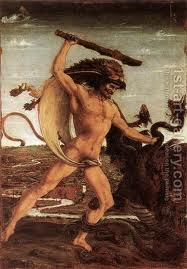The Hydra or Lernaean Hydra was a many headed monster in Greek mythology which terrorized visitors near the lake of Lerna in Greece. Killing the Hydra proved to be quite a challenge, as two heads would grow back whenever one was cut off. Hercules seized upon the idea of cauterizing the neck before the new heads had a chance to grow, ultimately defeating the monster as part of a series of tasks he completed which are collectively known as the 12 labors of Hercules. The Hydra is such an enduring mythological figure that the term “hydra” is sometimes used to describe a challenge which seems to keep getting bigger and harder to handle, no matter how hard someone tries to metaphorically behead it.
n most stories, the Hydra is the child of Typhon and Echidna, and the monster was put in place to guard an entrance to the underworld. The monster has been described as having anywhere from five to “a multitude” of heads, although in many stories nine heads is the accepted number. In addition to having multiple heads, the Hydra also had poisonous breath and blood, making it an undoubtedly formidable opponent. The many headed serpent was related to other nasty characters in Greek mythology including the Chimera and Cerberus, the many headed dog.
 According to legend, Hercules bested the Hydra with the assistance of his relative Iolaus. He approached the Hydra with a cloth over his nose to protect himself from the monster's breath, and while he cut off the Hydra's heads, Iolaus burned the neck stumps with a blazing torch. After the two succeeded in the task of killing the Hydra, Hercules dipped his arrows in the poisonous blood and then they buried the monster, positioning a large rock over it in case it got any ideas about coming back from the dead.
According to legend, Hercules bested the Hydra with the assistance of his relative Iolaus. He approached the Hydra with a cloth over his nose to protect himself from the monster's breath, and while he cut off the Hydra's heads, Iolaus burned the neck stumps with a blazing torch. After the two succeeded in the task of killing the Hydra, Hercules dipped his arrows in the poisonous blood and then they buried the monster, positioning a large rock over it in case it got any ideas about coming back from the dead.Visual depictions of the Hydra vary immensely, although most give the monster the body of a serpent with heads like snakes, lizards, or dragons. These heads often have vicious teeth and horns to further convey the danger of tangling with the Hydra. According to some tales, this feat of Hercules was not formally recognized, because he required assistance to complete it. Hercules completed a number of other daring tasks, including capturing Cerberus and capturing the Cretan Bull. The 12 labors of Hercules were undertaken as a form of penance, and they have become a popular theme in tales of heroism and atonement from other regions of the world.The Hydra was a many-headed monster slain by Heracles. It was related to the Chimaera and Cerberus. As one of his Labors, Heracles sought the Hydra's lair in the swamps of Lerna and forced it out into the open with flaming arrows. Wading bravely into the fray, he began to hack at the monster with his sword. But every time he cut off one head, two grew in its place. Eventually, Heracles called on his charioteer to bring a torch to cauterize the Hydra's severed neck each time a head was lopped. This prevented new heads from sprouting. And when the final head was chopped off and buried beneath a rock, the monster died.


No comments:
Post a Comment